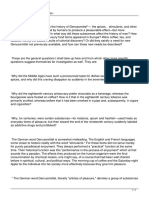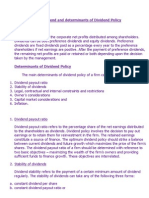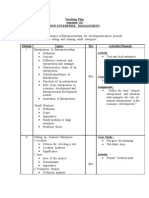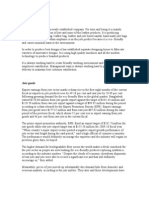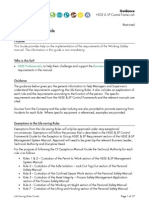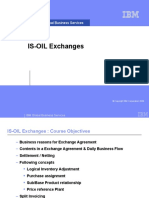Objectives of The Price Policy
Objectives of The Price Policy
Uploaded by
Prasanna HegdeCopyright:
Available Formats
Objectives of The Price Policy
Objectives of The Price Policy
Uploaded by
Prasanna HegdeOriginal Description:
Original Title
Copyright
Available Formats
Share this document
Did you find this document useful?
Is this content inappropriate?
Copyright:
Available Formats
Objectives of The Price Policy
Objectives of The Price Policy
Uploaded by
Prasanna HegdeCopyright:
Available Formats
Objectives of the Price Policy The following objectives are to be considered while fixing the prices of the product.
1. Profit maximization in the short term The primary objective of the firm is to maximize its profits. Pricing policy as an instrument to achieve this objective should be formulated in such a way as to maximize the sales revenue and profit . Maximum profit refers to the highest possible of profit. In the short run, a firm not only should be able to recover its total costs, but also should get excess revenue over costs. This will build the morale of the firm and instill the spirit of confidence in its operations. It may follow skimming price policy, i.e., charging a very high price when the product is launched to cater to the needs of only a few sections of people. It may exploit wide opportunities in the beginning. But it may prove fatal in the long run. It may lose its customers and business in the market. Alternatively, it may adopt penetration pricing policy i.e., charging a relatively lower price in the latter stages in the long run so as to attract more customers and capture the market. 2. Profit optimization in the long run The traditional profit maximization hypothesis may not prove beneficial in the long run. With the sole motive of profit making a firm may resort to several kinds of unethical practices like charging exorbitant prices, follow Monopoly Trade Practices (MTP), Restrictive Trade Practices (RTP) and Unfair Trade Practices (UTP) etc. This may lead to opposition from the people. In order to over come these evils, a firm instead of profit maximization, aims at profit optimization. Optimum profit refers to the most ideal or desirable level of profit.Hence, earning the most reasonable or optimum profit has become a part and parcel of a sound pricing policy of a firm in recent years. 3. Price Stabilization Price stabilization over a period of time is another objective. The prices as far as possible should not fluctuate too often. Price instability creates uncertain atmosphere in business circles. Sales plan becomes difficult under such circumstances. Hence, price stability is one of the pre requisite conditions for steady and persistent growth of a firm. A stable price policy only can win the confidence of customers and may add to the good will of the concern. It builds up the reputation and image of the firm. 4. Facing competitive situation One of the objectives of the pricing policy is to face the competitive situations in the market. In many cases, this policy has been merely influenced by the market share psychology. Wherever companies are aware of specific competitive products, they try to match the prices of their products with those of their rivals to expand the volume of their business. Most of the firms are not merely interested in meeting competition but are keen to prevent it. Hence, a firm is always busy with its counter business strategy. 5. Maintenance of market share
Market share refers to the share of a firm's sales of a particular product in the total sales of all firms in the market. The economic strength and success of a firm is measured in terms of its market share. In a competitive world, each firm makes a successful attempt to expand its market share. If it is impossible, it has to maintain its existing market share. Any decline in market share is a symptom of the poor performance of a firm. Hence, the pricing policy has to assist a firm to maintain its market share at any cost. 6. Capturing the Market Another objective in recent years is to capture the market, dominate the market, command and control the market in the long run. In order to achieve this goal, sometimes the firm fixes a lower price for its product and at other times even it may sell at a loss in the short term. It may prove beneficial in the long run. Such a pricing is generally followed in price sensitive markets. 7. Entry into new markets. Apart from growth, market share expansion, diversification in its activities a firm makes a special attempt to enter into new markets. Entry into new markets speaks about the successful story of the firm. Consequently, it has to bear the pioneering and subsequent risks and uncertainties. The price set by a firm has to be so attractive that the buyers in other markets have to switch on to the products of the candidate firm. 8. Deeper penetration of the market The pricing policy has to be designed in such a manner that a firm can make inroads into the market with minimum difficulties. Deeper penetration is the first step in the direction of capturing and dominating the market in the latter stages. 9. Achieving a target return A predetermined target return on capital investment and sales turnover is another long run pricing objective of a firm. The targets are set according to the position of individual firm. Hence, prices of the products are so calculated as to earn the target return on cost of production, sales and capital investment. Different target returns may be fixed for different products or brands or markets but such returns should be related to a single overall rate of return target. 10. Target profit on the entire product line irrespective of profit level of individual products. The price set by a firm should increase the sale of all the products rather than yield a profit on one product only. A rational pricing policy should always keep in view the entire product line and maximum total sales revenue from the sale of all products. A product line may be defined as a group of products which have similar physical features and perform generally similar functions. In a product line, a few products are regarded as less profit earning products and others are considered as more profit earning. Hence, a proper balance in pricing is required. 11. Long run welfare of the firm
A firm has multiple objectives. They are laid down on the basis of past experience and future expectations. Simultaneous achievement of all objectives are necessary for the over all growth of a firm. Objective of the pricing policy has to be designed in such a way as to fulfill the long run interests of the firm keeping internal conditions and external environment in mind. 12.Ability to pay Pricing decisions are sometimes taken on the basis of the ability to pay of the customers, i.e., higher price can be charged to those who can afford to pay. Such a policy is generally followed by those people who supply different types of services to their customers. 13. Ethical Pricing Basically, pricing policy should be based on certain ethical principles. Business without ethics is a sin. While setting the prices, some moral standards are to be followed. Although profit is one of the most important objectives, a firm cannot earn it in a moral vacuum. Instead of squeezing customer, a firm has to charge moderate prices for its products. The pricing policy has to secure reasonable amount of profits to a firm to preserve the interests of the community and promote its welfare.
You might also like
- OceanofPDF - Com Baby Reindeer - Richard GaddDocument112 pagesOceanofPDF - Com Baby Reindeer - Richard GaddKris AngelNoch keine Bewertungen
- Mergers and Acquisitions Assignment FinalDocument15 pagesMergers and Acquisitions Assignment Finalanuji46% (13)
- Inter-Firm ComparisonDocument10 pagesInter-Firm ComparisonMohd sakib hasan qadriNoch keine Bewertungen
- Theories of ProfitDocument6 pagesTheories of Profitvinati100% (1)
- Business Organization For BbaDocument101 pagesBusiness Organization For BbaVineet Walia100% (1)
- Mutual Fund SEBI RegulationDocument17 pagesMutual Fund SEBI RegulationSarvesh ShuklaNoch keine Bewertungen
- Taste of Paradise Chapter 0 PREFACIODocument2 pagesTaste of Paradise Chapter 0 PREFACIOGisele FerreiraNoch keine Bewertungen
- Employer Branding GuideDocument42 pagesEmployer Branding GuideTrí Nguyễn AnthonyNoch keine Bewertungen
- Unit 1 - HRMDocument43 pagesUnit 1 - HRMbalajiNoch keine Bewertungen
- Becg Unit-4.Document12 pagesBecg Unit-4.Bhaskaran Balamurali100% (2)
- Capital StructureDocument4 pagesCapital StructureNaveen GurnaniNoch keine Bewertungen
- Business Ethics in IndiaDocument3 pagesBusiness Ethics in Indianikhu_shuklaNoch keine Bewertungen
- Indian Marketing EnvironmentDocument9 pagesIndian Marketing EnvironmentRaju VeluruNoch keine Bewertungen
- Company Regulatory Legislations in IndiaDocument42 pagesCompany Regulatory Legislations in IndiaAngad SinghNoch keine Bewertungen
- Introduction To IFRSDocument13 pagesIntroduction To IFRSgovindsekharNoch keine Bewertungen
- Strategic Management Unit 1Document25 pagesStrategic Management Unit 1Praveen Kumar100% (1)
- Sickness in Small EnterprisesDocument15 pagesSickness in Small EnterprisesRajesh KumarNoch keine Bewertungen
- Differences Between Piece Rate System and Time Rate System of Wage PaymentDocument1 pageDifferences Between Piece Rate System and Time Rate System of Wage PaymentSugato C MukherjiNoch keine Bewertungen
- Marketing in Indian EconomyDocument15 pagesMarketing in Indian Economyshivakumar NNoch keine Bewertungen
- Micro Finance RoleDocument35 pagesMicro Finance Roleanon_583145487100% (1)
- Chapter 3 - Incorporating Investor Behavior PDFDocument9 pagesChapter 3 - Incorporating Investor Behavior PDFassem mohamedNoch keine Bewertungen
- Ihrm NotesDocument3 pagesIhrm NotesNeha KashyapNoch keine Bewertungen
- BBA Performance ManagementDocument16 pagesBBA Performance Managementnavin9849Noch keine Bewertungen
- Dividend and Determinants of Dividend PolicyDocument3 pagesDividend and Determinants of Dividend PolicyAmit PandeyNoch keine Bewertungen
- 206HRM Employee Relations and Labour Legislations (SPPU Uni. Sub. Prof. Notes.)Document37 pages206HRM Employee Relations and Labour Legislations (SPPU Uni. Sub. Prof. Notes.)Shrunali100% (1)
- Chapter 1 PDFDocument20 pagesChapter 1 PDFANILNoch keine Bewertungen
- AFM Important QuestionsDocument2 pagesAFM Important Questionsuma selvarajNoch keine Bewertungen
- New Enterprise ManagementDocument2 pagesNew Enterprise ManagementAnsheena AshaNoch keine Bewertungen
- B.B.A.Model PapersDocument3 pagesB.B.A.Model PapersHemanshu GhanshaniNoch keine Bewertungen
- Business Policy & Strategy: Unit 4Document73 pagesBusiness Policy & Strategy: Unit 4Harsh y.Noch keine Bewertungen
- Decision Theory: Chapter - 12Document24 pagesDecision Theory: Chapter - 12ALINDA BRIANNoch keine Bewertungen
- Major Arguments For and Against Social ResponsibilityDocument10 pagesMajor Arguments For and Against Social ResponsibilityMargielyn UmbaoNoch keine Bewertungen
- Maheshwari, S.N. Financial Management, Sultan & Sons Publications, New Delhi, 2006Document6 pagesMaheshwari, S.N. Financial Management, Sultan & Sons Publications, New Delhi, 2006tonyNoch keine Bewertungen
- FINANCIAL STRATEGY Formulation of Financial Strategy - Module: 1Document28 pagesFINANCIAL STRATEGY Formulation of Financial Strategy - Module: 1arul kumarNoch keine Bewertungen
- Project Report On Capital Structure On RelianceDocument7 pagesProject Report On Capital Structure On RelianceRashmi Kumari0% (1)
- Differenfce Between Various Types of AuditDocument3 pagesDifferenfce Between Various Types of AuditGhalib HussainNoch keine Bewertungen
- Management Financial ServicesDocument11 pagesManagement Financial ServicesTanmeet kourNoch keine Bewertungen
- Broad Profile of The Indian Economy & MacroDocument59 pagesBroad Profile of The Indian Economy & Macroyashaswi_raj0% (1)
- Bond Valuation NTHMCDocument24 pagesBond Valuation NTHMCAryal LaxmanNoch keine Bewertungen
- Risk Management NotesDocument1 pageRisk Management NotesViraja GuruNoch keine Bewertungen
- Banking Finanacial Services Management Unit I: Two Mark QuestionsDocument21 pagesBanking Finanacial Services Management Unit I: Two Mark QuestionsIndhuja MNoch keine Bewertungen
- Chap 009Document22 pagesChap 009Yarlagadda GayathriNoch keine Bewertungen
- Decision Making Without ProbabilitiesDocument1 pageDecision Making Without ProbabilitiesTimothy james PalermoNoch keine Bewertungen
- Bba Vnsgu Summer Internship Project On Raj Wafers 2022-23Document113 pagesBba Vnsgu Summer Internship Project On Raj Wafers 2022-23BrijeshNoch keine Bewertungen
- Unorganised Workers in India: Issues and ConcernsDocument35 pagesUnorganised Workers in India: Issues and Concernssuresh0% (1)
- The Notion of DominanceDocument8 pagesThe Notion of DominanceHarshit SinghNoch keine Bewertungen
- IR Globalisation& IRDocument10 pagesIR Globalisation& IRSujit SekharNoch keine Bewertungen
- Industrial Relations (KCP Cement) 2017Document80 pagesIndustrial Relations (KCP Cement) 2017krishnarao kalidasuNoch keine Bewertungen
- Unit-Iii Fundamental AnalysisDocument36 pagesUnit-Iii Fundamental Analysisharesh KNoch keine Bewertungen
- Nature and Importance of TraningDocument5 pagesNature and Importance of Traningarpit vermaNoch keine Bewertungen
- International Liquidity and Reserve ProblemsDocument34 pagesInternational Liquidity and Reserve ProblemsUthama Veeran50% (2)
- Chapter-2: 2.1. Concept of Individual BehaviourDocument56 pagesChapter-2: 2.1. Concept of Individual BehaviourJaya Raj JoshiNoch keine Bewertungen
- Managerial Economics:: According To Spencer and SiegelmanDocument10 pagesManagerial Economics:: According To Spencer and SiegelmankwyncleNoch keine Bewertungen
- A Sample Case Study On Contemporary Issue by Global Assignment HelpDocument21 pagesA Sample Case Study On Contemporary Issue by Global Assignment HelpInstant Essay WritingNoch keine Bewertungen
- Whether DerivativesDocument11 pagesWhether DerivativesPreity YadavNoch keine Bewertungen
- On RfaDocument14 pagesOn RfaSatheshaNoch keine Bewertungen
- Legal and Procedural Aspects of MergerDocument8 pagesLegal and Procedural Aspects of MergerAnkit Kumar (B.A. LLB 16)Noch keine Bewertungen
- Unit-Iv: The Sourcing DecisionsDocument31 pagesUnit-Iv: The Sourcing DecisionsGangadhara Rao100% (1)
- Clpa Xii New Branches of AuditingDocument7 pagesClpa Xii New Branches of AuditingSARFARAZ AHMADNoch keine Bewertungen
- Approaches To IRDocument10 pagesApproaches To IRprasadkhot123Noch keine Bewertungen
- GE 9 Cell MatrixDocument10 pagesGE 9 Cell MatrixMr. M. Sandeep Kumar0% (1)
- Value Chain Management Capability A Complete Guide - 2020 EditionFrom EverandValue Chain Management Capability A Complete Guide - 2020 EditionNoch keine Bewertungen
- International Strategic Management A Complete Guide - 2020 EditionFrom EverandInternational Strategic Management A Complete Guide - 2020 EditionNoch keine Bewertungen
- The Four Walls: Live Like the Wind, Free, Without HindrancesFrom EverandThe Four Walls: Live Like the Wind, Free, Without HindrancesRating: 5 out of 5 stars5/5 (1)
- Vedic MathsDocument220 pagesVedic Mathstargettutorials5740100% (7)
- Comparative Analysis of Non Performing Assets of Public Sector, Private Sector & Foreign BanksDocument73 pagesComparative Analysis of Non Performing Assets of Public Sector, Private Sector & Foreign BanksGaurav S. Godwani0% (1)
- M.S.Ramaiah Institute of Technology Department of Management StudiesDocument5 pagesM.S.Ramaiah Institute of Technology Department of Management StudiesPrasanna HegdeNoch keine Bewertungen
- Case StudyDocument24 pagesCase StudyPrasanna HegdeNoch keine Bewertungen
- RfidDocument11 pagesRfidVila HeffanyNoch keine Bewertungen
- ABC Sample Problems 1Document13 pagesABC Sample Problems 1Mary Grace PagalanNoch keine Bewertungen
- CHAPTER 9 Psychological Basis of Personality DevelopmentDocument25 pagesCHAPTER 9 Psychological Basis of Personality DevelopmentAshly ArdinaNoch keine Bewertungen
- Project ProposalDocument9 pagesProject ProposalNavin Nischal MandalNoch keine Bewertungen
- Life Saving Rules Guide-EnglishDocument17 pagesLife Saving Rules Guide-Englishgo4saint100% (1)
- Human RightsDocument3 pagesHuman RightsReybelyn T. CabreraNoch keine Bewertungen
- (Women in Africa and The Diaspora) Shireen Hassim - Women's Organizations and Democracy in South Africa - Contesting Authority (2006, University of Wisconsin Press) PDFDocument373 pages(Women in Africa and The Diaspora) Shireen Hassim - Women's Organizations and Democracy in South Africa - Contesting Authority (2006, University of Wisconsin Press) PDFClarisseGoulartParadisNoch keine Bewertungen
- Theories of An Active Audience-1Document14 pagesTheories of An Active Audience-1Shadow Knight 022Noch keine Bewertungen
- Letter of Recommendation - Jody TulsDocument2 pagesLetter of Recommendation - Jody Tulsapi-328819557Noch keine Bewertungen
- History Term 2 Study Notes PDFDocument9 pagesHistory Term 2 Study Notes PDFSaving Grace EducationNoch keine Bewertungen
- Trabajo Macroeconomia Carlos MarxDocument12 pagesTrabajo Macroeconomia Carlos MarxKaren Tatiana AbelloNoch keine Bewertungen
- Classical Theory BA 2nd SemDocument9 pagesClassical Theory BA 2nd SemVansh ChadhaNoch keine Bewertungen
- Celebrates: Iglesia Filipina IndependienteDocument1 pageCelebrates: Iglesia Filipina Independientezach andre mangaoilNoch keine Bewertungen
- Grammar Exercises - IouuhjkiDocument3 pagesGrammar Exercises - Iouuhjkinice weather to dreamNoch keine Bewertungen
- Jesus Is The LifeDocument5 pagesJesus Is The LifeKotch LupasiNoch keine Bewertungen
- SAP IS OIl - 1 - 06EXG010Document21 pagesSAP IS OIl - 1 - 06EXG010Naresh PNoch keine Bewertungen
- Final Report of WaterhealthDocument157 pagesFinal Report of WaterhealthAnkush Gupta100% (2)
- 2007-2009cat BookDocument650 pages2007-2009cat BookAbdul MalikNoch keine Bewertungen
- Human Rights PolicyDocument3 pagesHuman Rights PolicySaif RehmanNoch keine Bewertungen
- OpenWorkbench UserGuide ENU PDFDocument245 pagesOpenWorkbench UserGuide ENU PDFmatmatijamelNoch keine Bewertungen
- Partnership Deed FormatDocument34 pagesPartnership Deed FormatSAUMYA RAI 19213032Noch keine Bewertungen
- Causes of Delay in Construction ContractsDocument14 pagesCauses of Delay in Construction ContractsKABIRADO100% (3)
- What Is in A Drink1Document1 pageWhat Is in A Drink1Galaftion MihaiNoch keine Bewertungen
- Accessing Cisco Umbrella Sig Dcloud LabDocument2 pagesAccessing Cisco Umbrella Sig Dcloud LabnomoxpsNoch keine Bewertungen
- Paideia Final Paper - Nayunipati - 17-18Document10 pagesPaideia Final Paper - Nayunipati - 17-18api-389379178Noch keine Bewertungen
- B.S.S. Pass Course, Marks Distribution & Conpulsory SubjectDocument9 pagesB.S.S. Pass Course, Marks Distribution & Conpulsory SubjectCalvinNoch keine Bewertungen
- Promotion of FPO in Mayurbhanj Region Odisha: Dhan FoundationDocument9 pagesPromotion of FPO in Mayurbhanj Region Odisha: Dhan FoundationSahooNoch keine Bewertungen






